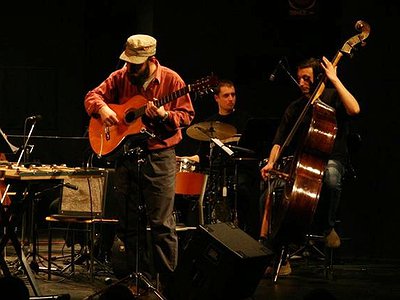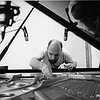Could you take us through a day in your life, from a possible morning routine through to your work? Do you have a fixed schedule? How do music and other aspects of your life feed back into each other - do you separate them or instead try to make them blend seamlessly?
Unfortunately, I don't have daily routine most of the time. Music and other aspects of my life intersect mutually - often even without my influence. I can't say I'm very disciplined, but from time to time, I do manage to be disciplined with an ordered daily routine for half or even a whole year at a time. That’s when I have the best focus; although some works that I consider to be among my best were written in pretty turbulent periods.
Could you describe your creative process on the basis of a piece or album that's particularly dear to you, please? Where did the ideas come from, how were they transformed in your mind, what did you start with and how do you refine these beginnings into the finished work of art?
To refer to my answer on 2nd question of this interview where I said that music is all about syntax - ideas or inspirations for my work are always coming from music itself. Sometimes it can be the color of the sound of a single tone or an interesting ratio of musical interval within a chord or chord progression. Often the basic idea for composition comes from rhythm or phrasing. At the moment, most my ideas come from the desire to explore the sound, properties and possibilities of microtonal harmony. Once I have defined the main subject of the work, the rest is a matter of time, craft, focus and strength. That is the part where true art is taking place!
There are many descriptions of the ideal state of mind for being creative. What is it like for you? What supports this ideal state of mind and what are distractions? Are there strategies to enter into this state more easily?
A focused mind combined with plenty of time to have no boundaries! That is the best ground for creative work. Time is something we can all access, but a focused mind is a different story - it differs from person to person. Some people achieve the best results under pressure while others crack. Some people left alone with no assignment get bored, while for others it's a trigger. Some people work best when they're in love while other don’t work at all! Focus and time are basic conditions for being creative.
How to achieve a focused state of mind? Simple discipline and routine - that is probably the best way but of course not the only one. Religion can bring people to a focused state of mind or different kinds of meditation or mental training or medication can do the trick as well.
Interest and curiosity focus the mind almost instantly and that is how it works for me most of the time.
How to achieve plenty of time? There are only two ways as far as I know - be organized or be irresponsible. Once I saw a documentary about the technology of building maximum security prisons, and how somebody always manages to escape, no matter how high the security level is. The prison employee said, "The mind of those who want to escape is focused only on one thing and they have all the time in the world - no technology can cope with that!"
How do you see the relationship between improvisation and composition?
The synthesis of improvised and written music was and still is one of my areas of interest. To achieve synthesis on a structural level through the whole piece, synthesis that is not just alternation of written and improvised parts in music, one must first find similarities and differences between the written and improvised music. At first it seems that improvised and written music are diametrically opposed but let us not forget that written parts in tonal improvised music are eminent as much as improvisation is eminent in written music.
Tonal improvised music has written form, harmony, measure, tempo and rhythmic phrasing, while melody is subject to improvisation. In written music, those parameters such as tempo or phrasing can be subject to interpretation, that is improvisation!
Allowing musicians to choose which notes to play, and when and how to play them, results with spontaneity in interpretation. This characteristic of improvised music is clearly audible even for audiences without any musical education. Complexity of form and richness of arrangements is another pair of attributes typical of written music that is equally easy to detect. In free improvised music, the only tools to build the form are player's experience and level of musical communication among them while playing.
So, here is the question: "How to sustain complex forms and rich arrangements and yet to allow the musicians the freedom to interpret?" Graphic scores are, I believe, a successful synthesis of written and improvised music on a structural level that can achieve complex form with rich arrangements and yet obtain spontaneity.
How do you see the relationship between the 'sound' aspects of music and the 'composition' aspects? How do you work with sound and timbre to meet certain production ideas and in which way can certain sounds already take on compositional qualities?
If by 'sound aspects of music' you refer to sound design, recording, sound engineering or production, than I have nothing to say about it because that is not the area of my interest. I always leave this part of the work to the professionals and limit my role to nothing more than suggestion. But, if you by 'sound aspects of music' refer to acoustic properties of the sound itself, then we are speaking about the very essence of my work. Sound is a fundamental building element in music and just intonation is a music system based on the structure of a single tone. Complete tuning is derived according to the upper structure of the tone, that is harmonics or partials. The principles of harmony in this kind of music system defer from standard musical harmony; this is the main subject of my work. I wrote a book on that subject "Five limit intervals - theory & praxis" and recorded the album "Just music" presenting original compositions that I analyzed in the 3rd chapter of the book.
Our sense of hearing shares intriguing connections to other senses. From your experience, what are some of the most inspiring overlaps between different senses - and what do they tell us about the way our senses work?What happens to sound at its outermost borders?
This is a special topic that I've been exploring and promoting for the last 10 years within multimedia project "Panmonism". The project is all about different perceptions of the same phenomena with the main focus on objective connections between music, mathematics, physics, optics and engineering. The whole event consists of a concert, animated movie, lecture and exhibition based on another invention of mine – a harmonograph prototype "Lira Spectrum" built in Bari, Italy and today permanently exhibited in a technical museum “Nikola Tesla” in Zagreb, Croatia.
Art can be a purpose in its own right, but it can also directly feed back into everyday life, take on a social and political role and lead to more engagement. Can you describe your approach to art and being an artist?
Just as you can use a shovel to hit someone with, you can use art for whatever you want. It was always like that and it will stay like that but it still doesn't make it its primary function. With arts using words and pictures from real life, it's just a little bit different but at least in abstract arts like music, the art should be for art's sake!
It is remarkable, in a way, that we have arrived in the 21st century with the basic concept of music still intact. Do you have a vision of music, an idea of what music could be beyond its current form?
Well, first of all I wouldn't say that the basic concept of music is still intact for it has changed and it's still changing all the time with the progress of science and technology. Most of the time, science was opening the door for art to develop. When Pythagoras discovered certain ratios among string lengths, it was the beginning of musical harmony. When physicists found out how to tune the instruments according to Aristoxenus’ calculations, they opened the door for romanticism, impressionism and 90% of the music that we know today. After the theory of relativity, serialism in music was born, followed by other new compositional techniques such as fragment, object, segment and moment.
Not to mention the changes brought by electricity and informatics. Today’s science and technology is literally opening the door for art to explore the audio micro cosmos and that could be the next step in music evolution.



